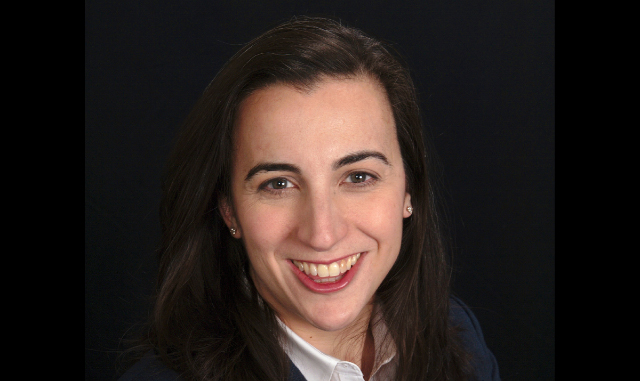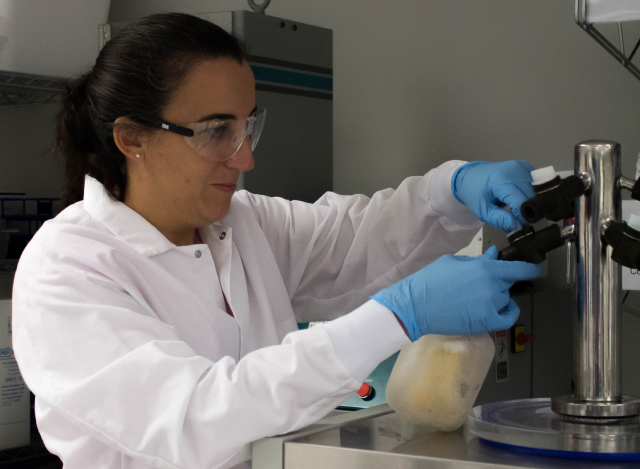Alumna develops breakthrough for broken bones
A physician can make a positive impact on every patient, but an engineer who develops the right biomedical device could potentially help millions of people suffering from an illness or injury.
Alumna Stephanie Kladakis, S.B. ’96, is that engineer. The chance to make an impact on many lives inspired her to pursue biomedical engineering at the Harvard John A. Paulson School of Engineering and Applied Sciences, rather than follow a path into the medical profession.
Today, Kladakis is vice president of research and development at Carmell Therapeutics, a 10-year-old regenerative medicine company headquartered in Pittsburgh. She is leading the development of its first product, a bioactive “putty” designed to accelerate healing of broken tibia bones.

The putty uses human blood platelets to promote healing for severe bone fractures which affect nearly half a million U.S. patients annually, according to the National Center for Health Statistics.
Bleeding is a critical part of the body’s normal healing response, Kladakis said. Platelets in the blood stick to the wound site, burst, and then release growth factors that tell the body to recruit cells to promote healing of the injury. Carmell’s novel bioactive putty contains a concentration of growth factors from donor blood that can be spread directly onto the broken part of the bone.
“In some of these hard-to-heal fractures, the patient would benefit by extending the healing responses after bleeding has stopped,” she said. “This bone putty is harnessing the power of naturally occurring, blood-derived growth factors, and concentrating that power where and when it is most needed with controlled release. While the engineering is complex, we are harnessing naturally occurring healing mechanisms.”
The company recently wrapped up a successful overseas clinical trial, which tested their bioactive product’s ability to accelerate healing of open tibia bone fractures. Kladakis is also managing preclinical development of similar bioactive products for enhancement of tissue healing.
She manages all aspects of each product’s development, from concept to final design. Since Carmell Therapeutics is a startup company with a small staff, Kladakis’s responsibilities extend beyond development to manufacturing. For an engineer who began her career at Johnson and Johnson, working at a startup offers unique challenges and tremendous learning opportunities.
“At a small company working on state-of-the-art medical products, resources are limited. We need to find the most efficient path to successful development. One of the biggest challenges we face is recognizing when to switch to Plan B after Plan A isn’t panning out,” Kladakis said. “And, maybe more importantly, how do you come up with multiple development options to begin with?”
The engineering and development expertise that Kladakis used to lead a successful clinical trial at Carmell Therapeutics drew on academic research skills strengthened while earning a doctorate in mechanical engineering at Georgia Tech, and her experience in product R&D gained throughout her industry career.

Though Kladakis enjoyed academic research, she felt drawn to industry for the opportunity to incorporate the latest scientific concepts into a commercial product that has the potential to improve lives.
“The academic side of me loves the science and being on the cutting edge of what is known,” she said. “The engineering part of me likes to figure out how to put all the pieces of the product development cycle together. It is very challenging to get from beginning to end.”
Now preparing for a U.S. and a European clinical trial of the bioactive bone putty, Kladakis is gearing up to face the regulatory hurdles that come with novel products. The bioactive bone putty is considered a biologic product since its composition includes blood products. Biologics don’t fit neatly into either of the FDA’s well-established regulatory pathways for pharmaceuticals or medical devices.
“Biologic product development has to follow most or all of the regulations established for drug products, but it’s a challenge to follow the regulations that just don’t fit a biologic product. Our bioactive putty is totally different than a pill,” she said. “The strict and ill-fitting regulations on biologic product development impede the growth of this area due to the cost, time, and uncertainties of developing these products.”
As the demand for and potential benefits of biologic-based medical products increase, Kladakis is hopeful that change will come. Bringing safe and effective products to patients in a way that is more financially sustainable for companies will require collaboration between government and industry, she said.
To overcome the challenges she meets every day as a manager and executive in a fast changing industry, Kladakis relies on the communication and collaboration skills she developed by studying engineering in a liberal arts environment at SEAS. But the true fun of her day-to-day work often comes down to the science itself, which is what drew her to this field to begin with.
“Biomedical engineering is very challenging, there aren’t easy solutions to the problems we look at,” she said. “But all those challenges aside, the potential of biomedical engineering is huge. We are really just trying to make products that work really well for our patients. Our desire is to get people back to work or back to their families faster, and that makes it a really rewarding problem to solve.”